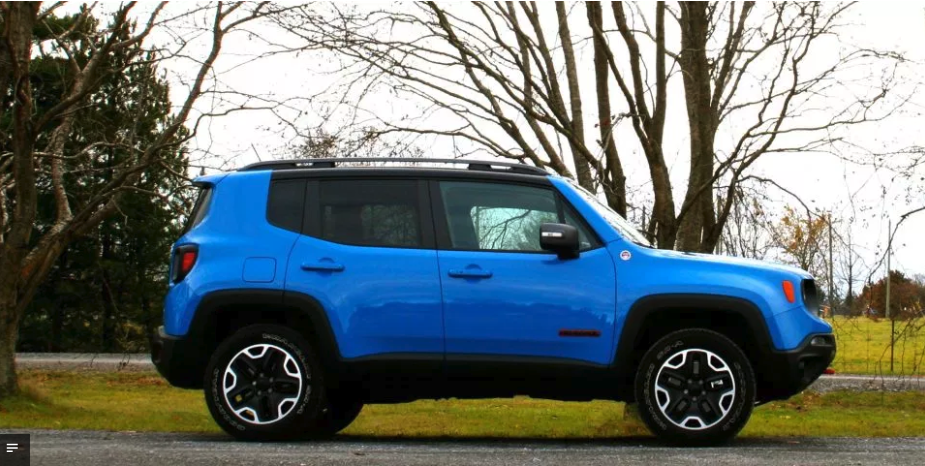Road Test: 2016 Jeep Renegade Trailhawk

Story and photo by John LeBlanc
With global sales rising on a yearly basis, Jeep continues to keep the coffers full over at Fiat Chrysler Automobiles. And part of the brand’s widening worldwide popularity is the addition of smaller car-based crossovers, such as last year’s compact Cherokee and this year’s even smaller Renegade.
On sale since earlier this year, the five-passenger, four-door 2016 Renegade shares the same front-wheel-drive-first compact platform as the Fiat 500X crossover (also new this year). Both are built in an Italian FCA plant, making the Renegade the first Jeep ever to be built exclusively outside of North America.
As a subcompact hatchback-based crossover, the Renegade – or what became known as “Baby Jeep” in our house – is part of a growing segment along with newbies like the equally fresh Mazda CX-3 and Honda HR-V. Similar to those cute-utes, FWD versions of the Renegade start at around $20,000, performing many of the functions drivers are looking for in a roomier and taller small hatchback car (see the Kia Soul).
Our all-wheel-drive $31,495 (base price) Renegade Trailhawk tester, though, was created to assuage any fears that an Italian-built, car-based Jeep would be a less capable off-roader than any other Jeep-badged vehicle. Wearing the famous “Trail Rated” badges, the Trailhawk was designed to handle off-road duties via extra traction, more ground clearance, improved manoeuvrability, more suspension travel and “water fording” capabilities.
Specifically, the Trailhawk is 20 millimetres farther from the ground than a regular Baby Jeep. Redesigned bodywork improves approach, break-over and departure angles. The Trailhawk’s turning radius is a foot tighter (all the better to wiggle through close-knit trails) and its all-wheel-drive system employs Jeep’s Active Drive Low to lock all four wheels, plus there’s a 4.33:1 axle ratio instead of the non-Trailhawk 3.73 gear for quicker launches.
As well, the Trailhawk’s AWD system includes Jeep’s Selec-Terrain traction management system (that can be set for Snow, Sand, Mud or Rock driving conditions) and hill-descent control. Externally, the rugged Renegade distinguishes itself with exclusive skid plates, red-painted tow hooks and white-letter Goodyear Wrangler SR-A off-road rubber.
We didn’t get a chance to “ford” any waters in our time in the Renegade Trailhawk. But among its more gentrified cute-ute rivals, the Jeep is the subcompact ute to get if you want to travel off the pavement with less fear of getting stuck or damaging expensive bodywork.
In our hands, the Renegade Trailhawk was more than capable at handling rough cottage trails and light off-roading in a local gravel pit. Like the larger Cherokee Trailhawk, the Trail Rated taller ride height and softer suspension cushions passengers from bumps and ruts, while its tidy dimensions make it easier to navigate narrow tracks.
In addition to its extra off-road equipment, the Renegade Trailhawk helps justify its additional fees with a substantial amount of other standard equipment over base Baby Jeep models. Instead of a turbocharged, 160-horsepower 1.4-litre four-cylinder and six-speed manual transmission sending power to the front wheels only, the Trailhawk comes with the aforementioned AWD system hooked up to a naturally aspirated 2.4-litre four with 180 horsepower and a nine-speed automatic, which also allows for a relatively substantial 907 kilograms (2,000 pounds) of towing capacity.
As well, our Renegade Trailhawk tester came with $6,280 worth of Trailer Tow, Premium Leather, Navigation, Safety and Security packages, plus a rear backup camera and MySky removable roof panels, causing our tester’s price to climb to $39,250 (including freight and pre-delivery inspection fees).
While options help nudge the subcompact Jeep’s price into luxury compact crossover territory, all the stuff that makes the Renegade Trailhawk so capable off-road makes it less comfortable on pavement.
Wind and noise from those knobby Goodyears is a constant presence. The combination of the Renegade’s short wheelbase and off-road tires made for a stiff highway ride. And unlike the CX-3 – which drives like a tall hot hatch – the Jeep understeers heavily, unaided by a soft suspension that allows for plenty of body roll in the corners.
We’re also not big fans of the Baby Jeep’s engine. The large displacement four-cylinder is loud at idle, and it needs to work hard against the Jeep’s rotund 1,620-kilogram curb weight: zero to 100 km/h takes a rather pedestrian 9.4 seconds (about one second behind the Mazda).
We’re also convinced that no vehicle needs nine gears. As in the Cherokee, the Renegade’s autobox can easily be caught deciding which gear it wants to be in. And if you think the Renegade Trailhawk’s diminutive size translates into small car fuel economy, think again: rated at 11.2 L/100 km in the city and 8.0 on the highway, we saw a midsize/V6 crossover-like average of 12.2.
In the end, the 2016 Jeep Renegade Trailhawk seems to be caught between a deep crevice and a steep cliff. In its desire to make a Fiat compact wagon Rubicon-ready, Jeep has over-engineered the Trailhawk for urban drivers; as a city car, it doesn’t handle or ride very well, while its fuel efficiency is not great.
And for similar dough, real off-roaders will likely go get themselves a Jeep Wrangler.
As much as we like the idea of an off-road-ready cute-ute, if you’re looking for a tall-and-small wagon with extroverted looks, the lower-priced FWD Baby Jeeps are the better buys.





![[del.icio.us]](https://www.straight-six.com/wp-content/plugins/bookmarkify/delicious.png)
![[Digg]](https://www.straight-six.com/wp-content/plugins/bookmarkify/digg.png)
![[Facebook]](https://www.straight-six.com/wp-content/plugins/bookmarkify/facebook.png)
![[Google]](https://www.straight-six.com/wp-content/plugins/bookmarkify/google.png)
![[Reddit]](https://www.straight-six.com/wp-content/plugins/bookmarkify/reddit.png)
![[StumbleUpon]](https://www.straight-six.com/wp-content/plugins/bookmarkify/stumbleupon.png)
![[Twitter]](https://www.straight-six.com/wp-content/plugins/bookmarkify/twitter.png)
![[Email]](https://www.straight-six.com/wp-content/plugins/bookmarkify/email.png)